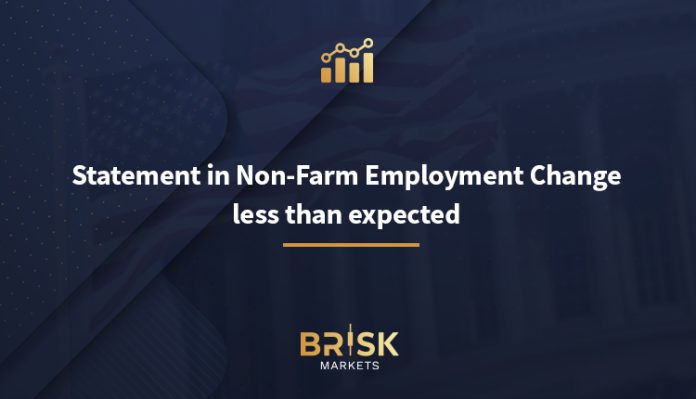An increase of 175,000 jobs in total nonfarm payrolls was recorded in April, and the unemployment rate rose slightly to 3.9%. Job gains were concentrated in the healthcare, social assistance, transportation and storage sectors.
According to the statement from the US Bureau of Labor Statistics, the unemployment rate stood at 3.9% in April, little changed from the previous month. A net increase of 175,000 jobs was recorded in non-agricultural sectors. These gains were concentrated in the healthcare, social assistance, transport and storage sectors..
As for demographic details, the unemployment rate among adult men rose to 3.6% in April, while the unemployment rate among adult women fell to 3.5%. A slight increase in unemployment rates was observed among youth and people of black origin, while unemployment rates stabilized among people of white, Asian and Latino descent..
On the other hand, the number of long-term unemployed (more than 27 weeks) stabilized at 1.3 million people in April. Labor force participation rates and the number of employment in general have stabilized..
The unemployment rate was 3.9 percent and the number of unemployed was $6.5 million, little changed in April. The unemployment rate has remained in a narrow range of 3.7 percent to 3.9 percent since August.
The number of people working part-time for economic reasons was little changed and stood at 4.5 million in April. The number of people who are not in the workforce and who currently wish to work is 5.6 million, and this number has not changed significantly..
These statistics reflect the state of the labor market in April, and provide an overview of the economic situation. It should be noted that these figures are subject to change and may vary in upcoming surveys.
US jobs report and its impact on financial markets and currencies
The latest U.S. jobs report showed a slowdown in hiring in April with only 175,000 new jobs added compared to expectations of 243,315,000 revised upwards in March (from 303K). Year-on-year average hourly earnings fell by a tenth of a percentage point to 3.9%, while the unemployment rate rose 0.1% to 3.9%.
Today’s release has pushed market expectations of a rate cut higher, with the latest prospects showing around 50 basis points for a rate cut this year. At the beginning of the week, that figure was about 28 basis points. According to market expectations, the September rate cut has now been fully calculated.
The US dollar fell sharply after the release of the Nonfarm Payrolls report, with the dollar index easily breaching the 105.00 level. The next support level, the 38.2% Fibonacci retracement, is at 104.38.
US indices rose after the jobs report as Nasdaq futures added 200 points before drifting slightly while S&P futures added just over 40 points.
The yen strengthened to 151 against the dollar in New York trading on Friday, the highest level in more than three weeks, after the release of weaker-than-expected U.S. payroll data.
U.S. nonfarm payrolls for April rose 175,000 from the previous month, Labor Department figures released Friday showed, compared with market estimates of nearly 240,000. The dollar sell-off has spanned a wide range of currencies due to the possibility of the US Federal Reserve moving to cut interest rates quickly.
The yen hovered around 153 during Asian market hours on Friday. Under the prevailing view that Japan intervened to buy yen early Thursday morning, Japan time, speculators broke up yen short positions, as the resulting purchases supported the currency.
US employment data and its impact on Bitcoin
Data on employment and nonfarm unemployment in the United States has been released, and the leading cryptocurrency, Bitcoin, is trying to recover from its sharp declines, which are close to $60,000. Currently at around $59,000, some analysts warn investors that the decline could continue.
Factors such as the decline in spot Bitcoin ETFs and the low probability of a Fed rate cut have weighed on this decline, with all eyes on the economic data coming out of the US today.
Bitcoin is responding to US employment data, as the leading cryptocurrency shows signs of recovery amid economic volatility.
Bitcoin’s reaction to the announced data
The data released every first Friday of the month is closely followed by investors and stakeholders to understand the state of the economy. The declared data are as follows:
· Nonfarm Employment Data: Reported 175K – Projected 238K – Previous 303K
· Unemployment data: 3.9% reported – forecast 3.8% – previous 3.8%
Higher-than-expected nonfarm employment data is a signal of that country’s economic recovery and has a positive impact on the currency. Changes in the labor market significantly affect the monetary policy of the Federal Reserve. The Fed, which believes the labor market needs to cool down as well as low inflation, is following the employment data closely.
If the reported data comes in above expectations, we could see the DXY (dollar index) rise and bitcoin fall slightly. If it comes below expectations, we could see a decline in the DXY. An increase in the unemployment rate could lead to a sharp decline in the Dollar Index (DXY). This will be positive for Bitcoin.
Bitcoin’s reaction to US employment data indicates the cryptocurrency’s sensitivity to global economic fluctuations. As the market continues to monitor these developments, we advise investors to be aware of potential volatility.



